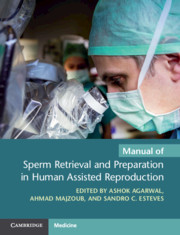Book contents
- Manual of Sperm Retrieval and Preparation in Human Assisted Reproduction
- Cambridge Laboratory Manuals in Assisted Reproductive Technology
- Manual of Sperm Retrieval and Preparation in Human Assisted Reproduction
- Copyright page
- Dedication
- Contents
- Contributors
- Editor Biographies
- Preface
- Part I Introduction
- Part II Sperm Retrieval
- Chapter 4 History of Surgical Sperm Retrieval Techniques
- Chapter 5 Epididymal Sperm Retrieval
- Chapter 6 Testicular Sperm Retrieval
- Chapter 7 Surgical and Nonsurgical Sperm Retrieval Techniques in Patients with Ejaculatory Dysfunctions
- Chapter 8 Sperm Retrieval in Non-azoospermic Men
- Chapter 9 Predictors of Positive Surgical Sperm Retrieval in Azoospermic Males
- Chapter 10 Methods for Enhancing Surgical Sperm Retrieval Success
- Part III Laboratory Handling of Retrieved Sperm
- Index
- References
Chapter 8 - Sperm Retrieval in Non-azoospermic Men
Indications, Protocol, and Outcomes
from Part II - Sperm Retrieval
Published online by Cambridge University Press: 09 April 2021
- Manual of Sperm Retrieval and Preparation in Human Assisted Reproduction
- Cambridge Laboratory Manuals in Assisted Reproductive Technology
- Manual of Sperm Retrieval and Preparation in Human Assisted Reproduction
- Copyright page
- Dedication
- Contents
- Contributors
- Editor Biographies
- Preface
- Part I Introduction
- Part II Sperm Retrieval
- Chapter 4 History of Surgical Sperm Retrieval Techniques
- Chapter 5 Epididymal Sperm Retrieval
- Chapter 6 Testicular Sperm Retrieval
- Chapter 7 Surgical and Nonsurgical Sperm Retrieval Techniques in Patients with Ejaculatory Dysfunctions
- Chapter 8 Sperm Retrieval in Non-azoospermic Men
- Chapter 9 Predictors of Positive Surgical Sperm Retrieval in Azoospermic Males
- Chapter 10 Methods for Enhancing Surgical Sperm Retrieval Success
- Part III Laboratory Handling of Retrieved Sperm
- Index
- References
Summary
Sperm retrieval and intracytoplasmic sperm injection (ICSI) has become the natural treatment for couples with azoospermia-related infertility, and nowadays is also used for nonazoospermic indications. An increasing body of evidence overwhelmingly based on cohort studies has indicated that ICSI with ejaculated sperm of poor quality negatively affects the chances of assisted conception. Collectively, these data suggest that ICSI with testicular sperm is superior to ICSI with ejaculated sperm as a method of fertilization to overcome sperm DNA fragmentation-related infertility. The candidates are men with high sperm DNA damage in semen and those with severe oligozoospermia or cryptozoospermia. In these patients, percutaneous and open sperm retrieval are highly successful to harvest sperm, with few complications. Current evidence suggests the safe utilization of testicular sperm for ICSI in nonazoospermic men. Further research is warranted to confirm the clinical utility of this approach as a routine ART treatment.
Keywords
- Type
- Chapter
- Information
- Publisher: Cambridge University PressPrint publication year: 2021
References
- 1
- Cited by

